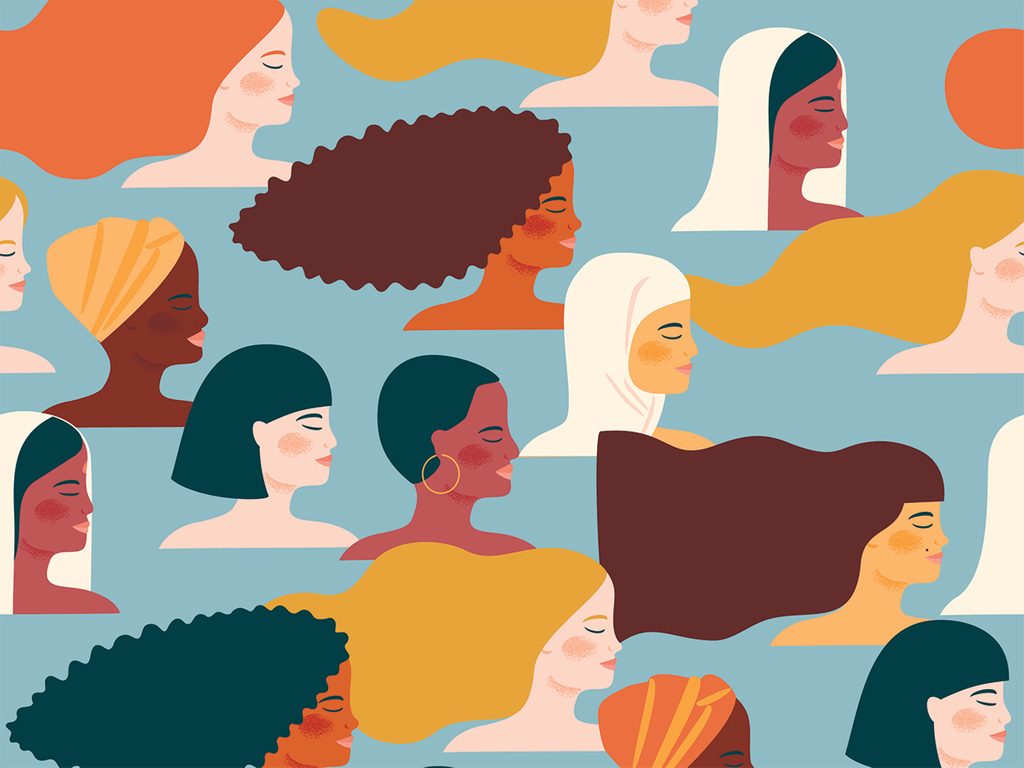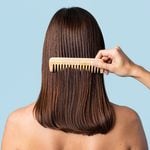The Root Cause of Thinning Hair and Hair Loss for Women

It's not just hair. There, we said it. Our 'dos are deeply entangled with our identities, our self-confidence and even our moods. Since the majority of us will deal with hair loss at some point in our lives, it's time to get to the root of the problem.
When her thinning hair got to the point where she was using an eyebrow pencil to colour in her scalp to disguise the bald spots, Laura Brown* knew it was a problem. She stopped wearing ponytails at work because pulling her hair back seemed to accentuate her retreating hairline. “I avoided touching my hair in public because it would just fall out in my hands,” says the 34-year-old. “I was so self-conscious.”
Hair’s the Thing
We all lose hair every day. Shedding is part of the natural hair cycle of growth, rest, loss and replacement. In fact, it’s perfectly normal to shed as many as 100 strands a day. But when these hairs aren’t replaced right away or more hairs shed at one time than they should, we may notice thinning and even bald patches. This interruption in the natural cycle is more common as we age and can be attributed to physical or emotional shocks to the body, underlying diseases, hormonal imbalances and even nutritional deficiencies. Many women experience increased hair loss as they age. “About 40 percent of women experience some kind of hair loss before the age of 50,” says Caroline Ruggiero, a certified trichologist with Truly You Hair & Scalp Clinic in Mississauga, Ont., “and that number goes up after menopause.” Sometimes drastic hair loss is temporary, but other times it’s permanent. Either way, women feel that loss.
The Real Reason Why Your Ponytail Is Shrinking
At 30, Brown was diagnosed with a range of autoimmune disorders. Five years ago, she was put on an immunosuppressant drug that’s known to cause hair loss. “The hair loss affected me more mentally and emotionally than I thought it would,” says Brown, who went off the drug two years ago. Hair thinning is a side effect of a number of medications used for managing everything from high blood pressure to cholesterol levels to mood disorders. Often, the hair will return when the dose is adjusted or the drug is stopped.
But medication is just one reason why we can start losing a lot of hair. Alopecia areata occurs when the affected hair follicles are attacked by the person’s own immune system, which can stop strands in the growth phase and lead to bald patches or, in some cases, complete body hair loss. (This condition is more common in young adults, but it can happen in later life, too.) Diffuse thinning all over can also be caused by drastic hormonal changes that occur postpartum and conditions like polycystic ovary syndrome. A traumatic event, like the sudden death of a loved one or the shock of a major surgery, can cause telogen effluvium, where hair comes out in clumps, resulting in bald spots.
But the most common cause of a thinning ponytail is androgenetic alopecia, also called female pattern hair loss (FPHL), and it accounts for about 95 percent of all hair loss. FPHL is related to the predominance of dihydrotestosterone (DHT), which essentially deadens hair follicles and causes hair to fall out. It can start in midlife, often with a widening part, and sometimes progress to overall thinning. But most women don’t lose all of their hair like men do. FPHL runs in families and affects some women more than others, says Ruggiero.
Environmental factors, lifestyle issues and diet can also affect hair thinning. Poor sleep plays a larger role than you might think, too, says Ruggiero. If you miss out on rapid eye movement (REM) sleep, you could also miss out on some initiation of the liquid keratinization process that’s supposed to happen in the hair follicle and grow into hair.
Poor hair care can also harm your strands and lead to overall thinning, says Ruggiero. Too-tight buns, braids and extensions can cause stress on the hair follicle, making strands fall out before they should. You may also want to put down that bottle of dry shampoo. Despite what hairstylists may have told you over the years, if you wash your hair only once or twice a week, you’re probably doing more harm than good, says Ruggiero. The scalp produces sebum, a waxy oil designed to fight off harmful bacteria and coat and protect the hair shaft. When sebum is left to harden, it can become like a blackhead, she says, blocking the hair follicle and preventing your skin’s natural oils from moving down to the lengths. The result? Brittle ends and an oily-looking scalp.
Stress can be another big factor. When your endocrine system goes into fight-or-flight mode during times of extreme stress or anxiety, nonessential tissues cease to function, so your hair can actually stop growing and start to fall out. “If someone leads a high-stress lifestyle, the best thing they can do is not hold that stress in and bottle it up,” says Ruggiero. “Find a release with an activity that’s good for your mind and body.”
Get Growing
Running and going to the gym several days a week were Rosa Smith*’s ways of dealing with stress. The 37-year-old busy mom of two from Camrose, Alta., thought she was managing her hectic life until she started to notice major thinning along her hairline and her stylist discovered bald patches on the back of her scalp. She eventually went to see her nurse practitioner for help. After running full blood panels to rule out nutritional deficiencies, thyroid disease and other hormonal issues, they determined that Smith’s significant shedding was stress induced.
Everyone from the office to the hair salon offered suggestions ranging from medicated shampoos to multivitamins, says Smith. “I’ve ‘trialled and errored’ a lot of products;’ she says. “There are so many products out there, but, unfortunately, it’s not a one-fits-all solution.” Plus, hair grows really slowly, so it’s tough to figure out what really works once you get a cocktail of over-the-counter hair care products and supplements going. In most cases, you need to try something for at least three to six months before you know if it actually boosts hair growth.
Smith was also prescribed Rogaine to get some regrowth going, but she isn’t sure it helped much. DHT-inhibiting drugs like Propecia are often prescribed to treat genetic hair loss, but Ruggiero isn’t convinced they’re the answer. “These medications aren’t regrowing everybody’s hair,” she says. “They’re helping a little but not completely. In general, I think less of the focus needs to be on DHT for women. It really needs to be on diet, nutrition, health and lifestyle because these factors can aggravate hormonal imbalances and genetic predispositions.”
If you manage your stress and get enough zzzs, the next thing to focus on more closely may be your diet. “There are a lot of different micronutrients and macronutrients that are connected to hair growth,” says Ruggiero, “and there is a small but specific list of ones that are closely connected to how quickly hair grows in women.” These include vitamins B12 and D and iron, which are essential for tissue growth. “The normal range for women’s iron levels is between 20 and 200, but your ferritin levels need to be at least 70 for hair to grow well,” she says.
In the Thick of It
Eventually, Brown was switched to a different immunosuppressant drug for other medical reasons, but she was relieved to be off the medication that was causing her hair loss. It took a few months, but eventually her locks began to grow back. “It was like Christmas morning when I finally noticed my hair coming back in,” she says.
Smith is still waiting to see more strands appear and for a referral to a dermatologist to dive deeper into what else might be causing her bald patches and thinning hairline. In the meantime, she is taking supplements (including collagen and a new multivitamin), attempting to keep the hectic family schedule manageable to avoid unnecessary stress and ultimately trying to come to terms with her hair loss. She has had to swap her long bob for a cropped style because it helps conceal some of the sparse spots, but she just doesn’t feel like herself in her short ‘do. “There are still a lot of days where I’m getting ready for work and I look in the mirror and, well, it’s tough,” she says.
For women dealing with the overall thinning of FPHL, this much is clear. “There’s no cure for aging,” says Ruggiero. “You can’t jump into a fountain of youth and be 20 forever. But we know that if we do certain things throughout our lives, we’ll look younger longer, and hair is very much the same.” Having healthy hair starts with eating a healthy diet (to ensure that your iron and vitamin B12 and D levels are in a range that your hair needs for optimal growth) and using hair products that will benefit your mane. There are real solutions.”
Products to Try
Supplements, shampoos and leave-in treatments can help boost healthy hair growth if they support the particular needs of your scalp and strands or conceal thinning while you get to the root of the problem. (If you’re unsure of your hair needs, consult a trichologist or dermatologist for a treatment plan.) Here are just a few of the products available that are proven to deliver results:
- L’Oreal Professionnel Serioxyl Denser Hair Serum, a daily leave-in product to use on damp hair, is enriched with five percent stemoxydine and resveratrol to stimulate hair growth overtime.
- Viviscal Extra Strength is a twice-daily supplement that contains biotin, vitamin C and iron to promote thicker, fuller-looking hair after three to six months of use (and it’s backed by nine clinical trials).
- Available in nine shades, Toppik Hair Building Fibers are natural keratin hair strands that blend into your hairline for an instantly fuller look.
*Names changed to protect privacy
Next, learn the at-home trick doctors recommend for thinning hair.




